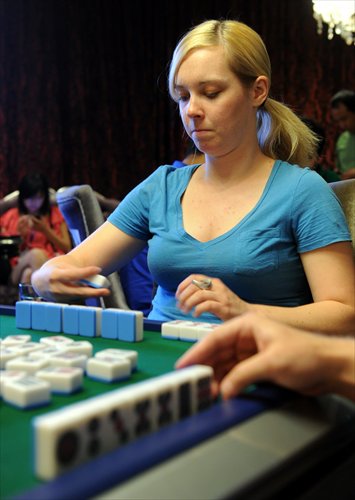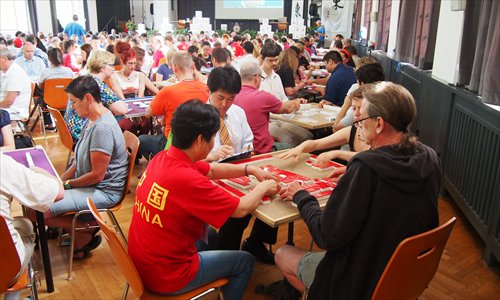Mad for mahjong
More foreigners are playing than ever, and they are beating the Chinese at their own game

As opposed to the predominance of middle-aged Chinese mahjong players, foreign players of mahjong tend to be younger and highly educated. Photo: CFP
It is a familiar scene in many a card parlour or street corner in Beijing. Old men, hairs graying or gone and bellies protruding crowded around a rectangular board. The clattering of plastic tiles with Chinese characters scrawled on them. Sweat dripping precipitously from their brows, an expression of stern concentration as they puff nervously on their cigarettes. And then the bursting of the dam, the cackling of laughter and gloating or complaints made in indignation and self-reprimand.
But in this particular crowd of mahjong players is something slightly less familiar: a ruddy-cheeked young Englishman of impressive girth, by the name of Charles de Pellette. A 24-year-old student who grew up in Hong Kong, de Pellette moves the tiles about the board with the deftness of an old hand.
"I have memories of seeing old Chinese men in Kennedy town in Hong Kong, sitting outside and playing mahjong late into the night," said de Pallette, recalling his childhood. "[They moved the tiles about] so quickly. It was almost unbelievable they could even see [them]."
Traditionally a game for Chinese scholars, with some even suggesting that it was invented by Confucius, mahjong has developed a following around the world. Although there are dozens of regional variations, the basic rules of mahjong are as follows. There are 144 tiles made up of various symbols, pictograms, and Chinese characters. A standard game has four players, with each player beginning with 13 tiles. Over a series of rounds, players discard, steal, or pick up new tiles, with the objective of forming combinations of three or more tiles (called "melds"), as in Rummy or Canasta. The game ends when any player chooses to pick up another player's discarded tile, in order to form a finishing "pair" in addition to the sets he or she has made, giving the player a final hand of 14 tiles.
"The way that tiles are put together [to form sets], with three of a kind or straights, makes it similar to a card game called Gin Rummy that we play in England," said de Pallette.
Though it is still not usual to see foreigners huddled playing mahjong in the hutong, it is not as unusual as some might think.
This year, the 5th European Mahjong Competition was held in Strasbourg, France, over three days in July. Given that the game originated in China, and boasts by far the largest number of casual players, it would be reasonable to expect that the Chinese contingent would clean up the competition. But in a stunning turn of events, the top three place getters were players from Germany and Japan. The two Chinese entrants finished 37th and 39th.
Not only has the rest of the world started playing mahjong, they are beginning to beat China at its own game.
Foreign experts
Although there are few professional players of mahjong in China or around the world, the number of serious casual players around the world has increased significantly in recent years, said Yao Xiaolei, the assistant secretary-general of the World Mahjong Organization(WMO) and team leader at the recent European championships.
According to Yao, foreign players tend to be younger and university-educated, while Chinese players are largely made up of people in their 50s and 60s, hailing from all walks of life.
"I'm quite surprised by how quickly the foreign players have improved," remarked Yao. "They know the rules inside out, and are able to adhere to them strictly. They even know how to call 'chi, peng, gang, hua, hu' [calls that players must announce when they hold a particular combination of cards]. Their pronunciation of the Chinese characters is not bad at all!"
According to Tina Christensen, president of Mahjong Denmark and the European Mahjong Association (EMA), the popularity of mahjong has grown enormously in Europe over the past decade.
Christensen was introduced to the game when the uncle of a friend brought back a set of mahjong tiles from China in 1998. She started playing in earnest with other students at University of Aarhus in Denmark, and two years later, along with other fellow mahjong enthusiasts, she formed Mahjong Denmark, the first national mahjong association in Europe.
The EMA was established five years later, in 2005. By then, there was already a small community of avid mahjong players organizing informal local tournaments, especially in the Netherlands and Italy, according to Christensen.
At present, the EMA has 19 member countries, with 540 ranked players who have attended elite competitions run by the WMO.
"I see people playing mahjong outside China all the time, and I play at least once a week in Copenhagen, Denmark," said Christensen. "I play several tournaments in Europe every year, and this year, I played [a tournament] in Japan as well."


Mahjong players from around the world test their mettle at this year's 5th European Mahjong Competition, held in Strasbourg, France. Photo: Courtesy of Tina Christensen
Playing the Chinese way
Away from the blood-and-thunder battles of competitive mahjong tournaments, a number of foreigners in Beijing are picking up the game as a hobby. For many foreigners, according to Chinese language teacher Yang Yu, playing mahjong is a way to learn more about Chinese culture, meet new people, and participate in local life.
Yang teaches at the Chinese Language Education (CLE), which hosts a mahjong night for all comers once a month. Among those who have attended the mahjong night, said Yang, were people from Israel, Peru, Columbia and South Africa, as well as Europe and the US. Of the cultural activities organized by the school, which include Chinese chess, kite-flying, and making lanterns, mahjong was the most popular, said Yang.
"It's fun but not always easy, and there is always room for improvement," said de Pallette, one of the students at the school.
"They give the mahjong tiles interesting nicknames," said Yang. One example, Yang said, was with a tile they called "M&M", because the pictogram resembled two inverted facing m's.
According to Yang, students usually take around two hours to get a basic idea of how to play the game, and even when they make mistakes, such as when to draw tiles or how to roll the dice (used to determine the deal), most students end up having a good time.
The most impressive mahjong player among her students, said Yang, was a 70-year-old American named Terry, who has resided in Beijing for four years, and lives alone.
"He is kind of stubborn and fond of solitude," said Yang. "But whenever we hosted a mahjong night, we would call him, and he would always appear within the hour."
These days, Yang and her workmates go to Terry's home every other weekend and during holidays to play mahjong with him.
"We joke that it's an act of charity, like spending time with the elderly," said Yang, smiling.
Cultural export
According to Jiang Xuanqi, secretary-general of the WMO, there are now more than 600 million people playing mahjong worldwide.
"Like poker, which was imported into China from Europe, mahjong is a way for China to export its culture into the world," said Jiang.
Jiang believes that mahjong reflects specifically a Chinese philosophy and mode of thinking, in contrast to games that originated in the West.
"Take the dice, for example," said Jiang. "Western dice are square, with hard angles on every edge, while Chinese dice are round and smooth. This reflects the Chinese attitude of 'letting nature run its course.' When you roll a rounded die, it takes longer for it to settle and become still, whereas with square dice, it is faster, thus satisfying the foreigners' need to see results right away."
According to Jiang, mahjong is now being implemented in a number of American elementary schools to help develop mental acuity, as well as in old person's homes to ward off dementia.
There's no place like home
While efforts are being made to further promote mahjong overseas, Jiang believes that it is equally important to preserve the history and competitiveness of mahjong in China.
The WMO is currently arranging for the migration of a mahjong museum with more than 30,000 artifacts from Chiba prefecture in Japan back to China.
The museum was established by Japanese businessman Kyoichiro Noguchi, a lifelong lover of the game. When Noguchi passed away in 2011, one of his dying wishes was that his massive collection of mahjong memorabilia be returned to China.
"We have not decided yet when and where to move it," said Jiang. "But it will be done very soon, for mahjong's sake - the treasure of all mankind!"
However, when de Pallette was asked whether he thought this might help China to ascend again to the top of the global ranks, the Englishman was nonplussed.
"I don't think that really means anything," said de Pallette. "The British invented lots of sports, such as rugby, football and cricket, but we hardly ever win anything!"